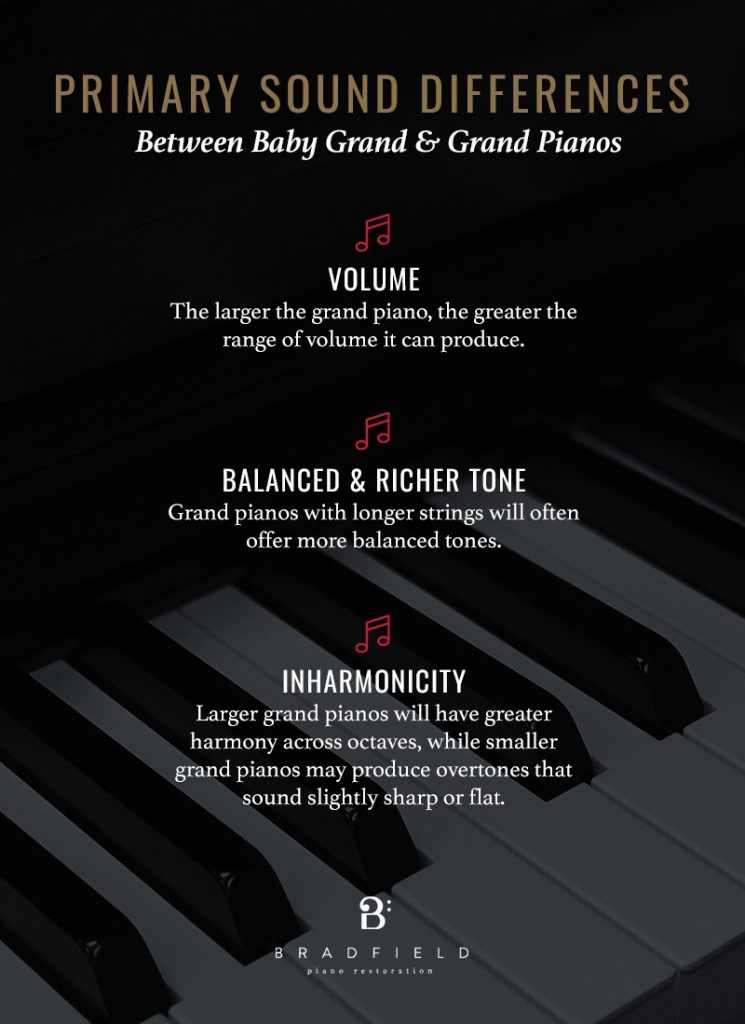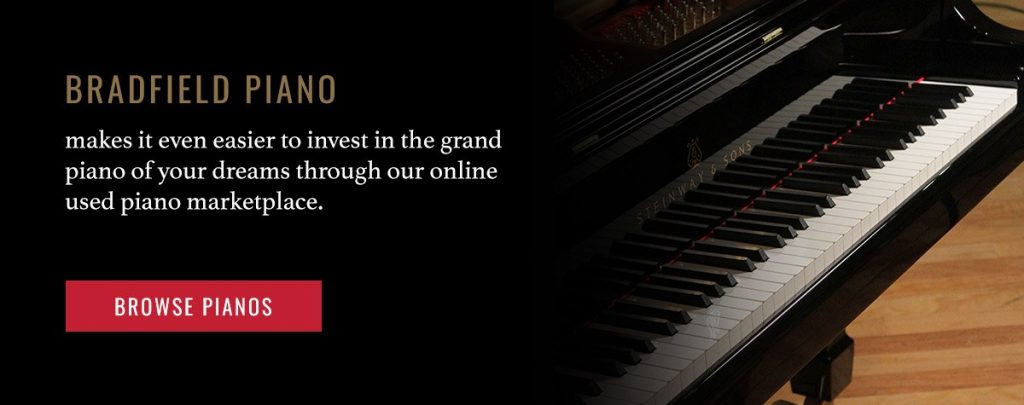
Grand pianos have always been a symbol of sophistication and class. Crafted with care and precision, a grand piano is both a beautiful and commanding instrument, as well as an elegant addition to any home, performance studio or concert hall. Producing a high-quality grand piano with an exceptional sound takes time and requires an intricate knowledge of the instrument. Some of the best piano manufacturers — like Steinway & Sons, Bösendorfer and Bechstein — have been perfecting the art of building grand pianos for centuries.
When shopping for a grand piano, there are many factors to consider — including the make, model and production year of the piano. There are also several sizes of grand pianos available, from petit baby grands to sprawling concert grand pianos. Each size of grand piano produces unique tonal qualities and is best-suited for different applications. If you are in the market for a new piano, you may find yourself wondering “what is the difference between a grand piano and a baby grand piano?”
In this piece, we will outline the size and sound differences between grand vs. baby grand pianos to help you select the perfect piano for you.
What Classifies Baby Grand Pianos and Grand Pianos?
There are two primary types of pianos: vertical pianos and horizontal pianos. Vertical pianos, also called upright pianos, are constructed with the strings oriented vertically. The hammers in an upright piano move horizontally and use springs to return to their resting position. Because the frame of a vertical piano is thinner and more compact than a grand piano, upright pianos are popular for home use and other small spaces. These more affordable pianos are also commonly used in schools, community centers and churches.

Horizontal pianos, commonly known as grand pianos, are oriented horizontally with the strings extending out from the keyboard. Both “grand” and “baby grand” pianos are classifications of horizontal pianos. When a player hits a note on a grand piano, the hammer strikes the string from underneath and returns to its resting position naturally with gravity. Because the action of a grand piano operates without springs, it is less subject to degradation than the action in an upright piano. The horizontal action of a grand piano also provides a crisper sound for repeated notes.
Although grand pianos are typically more expensive than upright pianos, they also offer greater responsiveness and improved tonal quality. Grand pianos allow the pianist to have better control of the sound they produce, making grand pianos the preferred choice for professional pianists and amateur musicians alike. Grand pianos can also create greater volume than upright pianos, especially when their top is raised. This makes grand pianos extremely effective for large spaces, such as concert halls and theaters. When used in homes, grand pianos offer a rich and full sound unmatched by their upright counterparts.
How Are Baby Grand Pianos and Grand Pianos Different?
Within the grand piano family, there are a variety of different sizes of grand pianos that each have their own classification. While the names “baby grand” and “grand” are commonly used to distinguish between small and large horizontal pianos, there are actually seven different size classifications of grand pianos. Depending on the piano manufacturer and where it was produced, the exact sizes may vary, but here are the commonly accepted classifications of grand pianos:
- Petit grand: The smallest size of grand piano, petit grand pianos range from about 4′ 5″ to 4′ 11″ in length. While petit grands are not able to produce the same volume or force as larger grand pianos, they are suitable for rooms where space is limited.
- Baby grand: One of the most popular grand pianos for domestic use, baby grand pianos measure between 5″ and 5′ 5″ and offer excellent sound quality at a more affordable price range than larger models.
- Medium grand: Also known as a classic grand, a medium grand piano ranges from 5′ 6″ to about 5′ 8″.
- Professional grand: Professional grand pianos are sometimes referred to as full grand pianos and measure between 5′ 9″ and 6′ 2″ long.
- Parlor grand: Measuring between 6’3″ and 6′ 10″, parlor grand pianos are another popular choice for home use. Parlor grand pianos create a striking centerpiece for any room, and their larger size produces a fuller and richer tone than smaller grand pianos. Parlor grand pianos are also called living room grand pianos or boudoir grand pianos.
- Semi-concert grand: Also known as a ballroom grand, a semi-concert grand measures between 6′ 11″ and 7′ 8″ in length. Semi-concert grands are popular in music halls and concert venues and are used by many professional musicians.
- Concert grand: The largest size of grand piano, concert grand pianos typically measure about 8’11” to 9″, but can sometimes be even larger. Compared to smaller grand pianos, concert grand pianos produce the greatest volume, richest sound and most balanced tone. Concert grand pianos are commonly used in orchestras, by professional pianists and in larger music venues.
Some piano manufacturers may classify their grand pianos into just three size categories: baby grand, grand and concert grand. Within these categories, a baby grand piano will typically be any piano under 6″ long, a grand will be between 6″ and 7″ and a concert grand will be any grand piano longer than 7″.
When shopping for a grand piano for domestic use, anything from a baby grand to a parlor grand may be the right fit. Grand pianos in this size range will offer a beautiful sound and resonance without being too forceful for a smaller space. When purchasing a grand piano for a concert venue or recital hall, a semi-concert grand or concert grand will fill the space and produce high-quality sound for professional performances.
Origin of the Baby Grand and Grand Piano
The history of the piano dates back to the 1700s with its invention by Bartolomeo Cristofori, a harpsichord maker from Padua. Cristofori sought to develop a more expressive instrument that could be played at different volumes, leading to his creation of the “pianoforte.” Cristofori’s pianoforte was modeled after the harpsichord but used hammers to strike the strings instead of plucking them. This allowed pianoforte — whose name translates to “loud and soft” — to be played louder or softer depending on how hard the player pressed the keys. Players could also sustain notes by holding down a key on the instrument, or create sharp staccatos by striking the keys quickly.
Due to its greater expressiveness and variable volume, the pianoforte — later shortened to “piano” — largely replaced the harpsichord by the end of the 18th century. As the popularity of the piano grew, it became a staple in the homes of distinguished families and was used by professional musicians and amateurs alike.

The word “grand,” meaning large, was first used to describe any piano — upright or horizontal — with long strings. Over time, grand became synonymous with horizontal pianos, which were typically larger than their upright cousins. For many years after their invention, upright pianos remained the most popular type of piano for domestic use due to their smaller footprint. However, manufacturers of grand pianos continued to develop smaller pianos that would be suitable for home use.
Although it is not certain exactly when the first baby grand piano hit the market, the term “baby grand” is often credited to the piano maker Hugo Sohmer. In 1884, Sohmer & Company produced the first 5″ grand piano that was later advertised as a baby grand piano. Since then, baby grand pianos have continued to be a popular feature in living rooms and parlors around the world.
Sound Differences Between Baby Grand Pianos and Grand Pianos
The primary difference between a grand piano and a baby grand piano is their length. However, the size of a grand piano can also impact its overall sound. Although the best baby grand pianos will sound very similar to a good grand piano, smaller grand pianos tend to produce less volume and have sharper overtones. Longer grand pianos often produce a fuller and richer sound with more balanced overtones. Perfect for larger spaces, grand pianos can also produce greater volume and more forceful sound than smaller baby grand pianos.
To better understand the differences in tonal quality between grand and baby grand pianos, let’s look at how inharmonicity is produced in grand pianos.
Inharmonicity is the degree to which the frequencies of an overtone deviate from whole number multiples of the fundamental frequency. The closer the overtones are to perfect multiples of the fundamental frequency, the cleaner and purer the sound will be. When an instrument has a higher degree of inharmonicity, the overtones will be slightly sharp or flat compared to a perfect harmonic. Inharmonicity is perceived as a tonal harshness and can cause octaves to sound sharp.
Most grand pianos produce very little inharmonicity and come close to this ideal harmonic series. However, the amount of inharmonicity a piano produces is also dependent on the size and stiffness of the piano strings. Pianos with shorter and thicker strings tend to have more inharmonicity than pianos with long and flexible strings. This means a larger grand piano will have less inharmonicity than a baby grand piano of the same quality.
While every instrument will have inharmonicity to some degree, the highest quality concert grand pianos can produce nearly perfect harmonic tones with almost no inharmonicity. Concert grand pianos can produce octaves that sound pure from the lowest to the highest registers.This low degree of inharmonicity gives concert grand pianos an unmatched tonal brilliance, which is precisely why they are the instrument of choice for professional pianists and performers.
Luckily, inharmonicity can be addressed through professional piano tuning, allowing smaller grand pianos to achieve more balanced tones. When a professional piano technician tunes a grand piano, the octaves of the piano are stretched slightly to account for the natural inharmonicity that is present in the instrument. Through precise tuning of each octave, grand pianos of any size can produce near-perfect harmonics.

To summarize, here are the primary sound differences between baby grand and grand pianos:
- Volume: The larger the grand piano, the greater the range of volume it can produce. The longer strings of a concert grand piano allow them to be played both more loudly and more softly than a baby grand piano. However, larger grand pianos also require more space to achieve proper resonance. A concert grand piano may overwhelm a small space, while a baby grand can fill it with full resonance.
- Balanced and richer tone: Grand pianos with longer strings will often offer more balanced tones. Larger grand pianos also produce more overtones than smaller grand pianos to create a fuller and richer sound.
- Inharmonicity: Larger grand pianos will have greater harmony across octaves, while smaller grand pianos may produce overtones that sound slightly sharp or flat. The timbre of baby grand pianos may also vary across octaves or with dynamics. While some musicians prefer the pure tonal quality of a concert grand piano, other pianists appreciate the unique voice of smaller grand pianos.
While the length of a piano does influence its tonal quality, in many cases, the quality of the piano has a greater influence on the instrument’s overall sound than its size. A baby grand piano produced by a top brand will outplay an inexpensive or poorly made grand piano. The highest quality grand pianos can even give a concert grand a run for its money. Whether you choose a grand piano or baby grand piano, you can still find a piano that offers exceptional tone quality, rich sound and dynamic musicality.
Which Is the Better Option?
When you purchase a grand piano from a quality piano company, any size of grand piano can offer a full and beautiful sound. However, baby grand and grand pianos are often better suited for different applications.

You’ll need to weigh the pros and cons of baby grand pianos and grand pianos to make your decision. The best grand piano for you will depend on the purpose of the piano, the professionalism of the player and the size of the room where the piano will be played. When choosing between a baby grand and a grand piano, here are four factors to consider.
1. ROOM SIZE
Grand pianos of any size will sound best when played in a spacious room with high ceilings. Ample space allows the piano to achieve proper resonance and be played dynamically. A larger grand piano will require more space, while a baby grand piano can offer excellent sound in a smaller room like a living room or classroom. When purchasing a grand piano, take accurate measurements to determine how much space you have available. Add a few extra feet to the length of the piano to account for the piano bench.
You should also consider the best route for moving the piano into your home or business. Measure your doorways and staircases to make sure the piano will fit. If you want to purchase a large grand piano but are not sure how to get it into your home, contact a professional piano moving service. Professional piano movers can help determine the best route for relocating your piano safely and smoothly.
2. PURPOSE OF THE PIANO
If you are purchasing a piano for a theater, recital hall or other performance space, a concert grand or semi-concert grand is often the best choice. These pianos produce a professional and clean sound that will easily fill a large concert space.
A mid-sized grand piano — such as a professional grand or parlor grand — will work well for a school theater, large music classroom or a music club or lounge. Standard grand pianos offer a rich sound while requiring less space than a full-sized concert grand piano. If you are purchasing a piano for teaching purposes, durability and price may also be a concern. You may opt for a slightly smaller grand piano or buy a used piano through a reputable piano retailer instead of directly from the manufacturer.
If you are considering a grand piano for its aesthetic value as an addition to your living space, a beautiful baby grand or medium grand piano may be the right choice. Baby grand pianos are also well-suited for your home and other small spaces.
3. PLAYER SKILL LEVEL
Professional pianists often prefer concert grand pianos for their improved tonal quality and resonance. Larger grand pianos offer near-perfect harmonics that allow a musician’s ability to shine. If you are a budding pianist, you may choose to start with a smaller grand piano as you continue to hone your skills.
For amateur musicians, a baby grand piano will allow you to wow your dinner party guests with a beautiful tune, while fitting comfortably in your parlor or dining room. A high-quality baby grand piano will still offer stunning sound for beginner pianists or those who enjoy playing piano for fun.
4. YOUR BUDGET
Grand pianos will range in price significantly depending on the model, manufacturer, production year and condition of the piano. However, baby grand pianos are typically less expensive than larger grand pianos. When considering the right grand piano for your budget, do not fall into the trap of simply purchasing the largest piano you can afford. Instead, focus on finding a high-quality piano in your price range. Remember that a quality baby grand piano will perform better than an inexpensive larger piano.
When you invest in a baby grand or grand piano, you also benefit from their slow depreciation. Because grand pianos lose value very slowly, you can often earn back much of what you invested originally if you choose to sell your piano in the future. This makes it easier for beginner pianists to purchase a baby grand piano first and then upgrade to a larger grand piano as their skill level and professionalism grows.
Grand and baby grand pianos both offer exceptional musicality and responsiveness that allow pianists to express their unique musical style. The beautiful tonality and rich sound of grand pianos make them an excellent choice for professional performers and amateur pianists alike. Whether you’re looking for a delicate baby grand piano for a small living room or a powerful concert grand to fill a recital hall, you can find the perfect grand piano for you.
Buying Your Dream Grand or Baby Grand Piano

Bradfield Piano makes it even easier to invest in the grand piano of your dreams through our online used piano marketplace. We carefully inspect and appraise each of our used pianos, so you can rely on finding a high-quality instrument at a fair price. After you purchase your grand piano, Bradfield Piano can provide piano tuning, cleaning and maintenance services to keep your piano in top conditions for years to come. We offer professional grand piano restorations for Steinways and a variety of other brands.
Explore the selection of baby grand and grand pianos at Bradfield Piano to find your perfect piano today.
